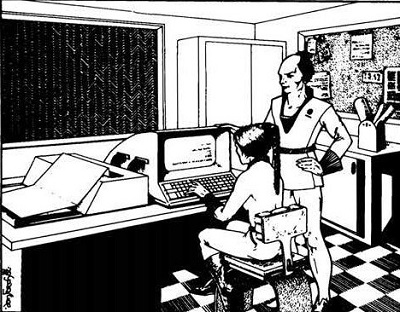Wafer Technology
Wafer Technology is a TL–13 era development combining three earlier technologies. First is Cybertechnology and the ability to construct direct connections between electronic computers and organic brains. Second is Personality Recording, the understanding of the sophont personality with sufficient detail to be able record as electronic data, copy, and edit it. Third would be the unique part of wafer technology, the ability to replay the personality via the cybernetic waferjack interface.
Description (Specifications)[edit]
Wafer technology in application consists of two parts; a waferjack, a cybernetic implant with direct access to the sophont's brain, and Wafers which are a data storage crystal specifically designed for holding and implanting a personality. Brain and Personality.
There are three kinds of wafers: entertainment, skillsofts, and overlay personalities. All of these require the user have a waferjack.
Entertainment wafers[edit]
These wafers contain an edited version of a span of time, or collections of the same. When used the wafer includes an entire world within. The user experiences this as a waking or lucid dream experience. Depending on the nature of the entertainment the user may simply experience the events as a passive viewer. Other wafers allow a degree of autonomy by the user, allowing for different outcomes of events or the entire entertainment. In all cases the user retains a memory of the events and decisions.
It is an evolution of virtual reality simulations, with complete sensory immersion in an experience.
Skillset wafers[edit]
The Skillset or skillsoft wafers contain an experiential databases, and memory experiences which allow a user to simulate skill in a field or improve their existing skill level. The skillset contains only the data necessary to perform specific specialized tasks. The user's personality remains in control during the period where wafer remains active.
Emergency overlay personality wafers[edit]
These wafers contain a complete personality, with skills and experiences intact. When used the wager personality completely overwhelms and suppresses the personality of the user for the duration of use. These are typically made from the personality of a highly skilled and respected person for use in emergency situations. The Angin-wafer is one of the best known types of wafer.
Limitation on use[edit]
Wafers made for one species may not used by another. The personality pattern overlay is too different and the system simply fails to work correctly. Most wafers are clearly labeled as to their species of origin.
The personality overlay process is not permanent and degrades quickly. The TL–13 wafer personality last a few hours. The TL–14 ones last a few days, and the TL–15 last a few weeks. As the overly personality degrades the skills and experiences granted by the wafer also degrade, leaving the original sophont personality with access to limited memories and abilities. This partial experience can cause psychological damage to the user. Manufacturers recommend removing the wafer at the first signs of degradation and allow the mind to heal to avoid permanent damage.
This limits the use of the Entertainment wafers to a few hours of use before the personality changes start showing flaws ruining the experience. Normally the software detects this and shuts down the software first.
Creating new wafers[edit]
The waferjack also allows a user to record their experiences and share them as a virtual reality adventure. Normally these are edited to remove any unwanted content, add story elements and decision points, and copied to new wafers.
To create skillsofts and emergency wafers a full personality recording is made and edited to include only the information necessary and that will fit onto the wafer data storage capacity.
History & Background (Dossier)[edit]
The Waferjack, was developed by the Solomani company UBM, initially as a way to speed up transfer of information.
The waferjack is essentially a computer data transfer interface wired directly into the cortex. However, after a lazy initial civilian market success, due mostly to social stigmas regarding cybernetic and bionic enhancements in the Solomani Rim, new uses were discovered. Users found that they could save and transfer memories, and experiences in addition to pure data. In addition to the development of skillsofts, this also sparked a new niche in entertainment, the virtual world exploded.
Due to the Imperium’s distaste for robotics, cybernetic and bionic enhancements, Waferjacks and Skillsofts are listed as a Class-3 Processor Device and are generally restricted and/or illegal on any planet of Law Level-4 or above.
Like computers, Waferjacks are rated for the complexity of software they can operate. The higher the skillsoft complexity, the more information and data provided. At the early tech levels, the device consists of a large module attached to the head. As the tech progresses, it all but disappears as it becomes completely subdermal.
Use of a Waferjack is not without risks. Anything that wires directly to the brain can be dangerous, and numerous early adopters suffered extreme brain damage from faulty waferjacks. Mandatory failsafes and feedback protocols have subsequently been developed, but there always remains a risk. In addition, extensive use of a waferjack over time can cause personality degradation, and/or other neurological disorders.
See also[edit]
Cybertechnology[edit]
Information Technology[edit]
References & Contributors (Sources)[edit]
| This article is missing content for one or more detailed sections. Additional details are required to complete the article. You can help the Traveller Wiki by expanding it. |
- Marc Miller. Agent of the Imperium (Far Future Enterprises, 2015), .
- Marc Miller, Robert Eaglestone, Don McKinney. Worlds and Adventures (Far Future Enterprises, 2019), 119,138,189.
- Wafer tech for Mongoose by Randy Dorman.
- Author & Contributor: Don Headrick
- Author & Contributor: Lord (Marquis) and Master of Sophontology Maksim-Smelchak of the Ministry of Science
